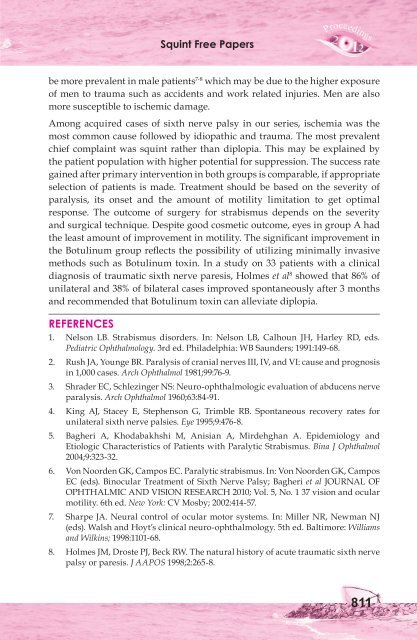Squint Free Papers - aioseducation
Squint Free Papers - aioseducation
Squint Free Papers - aioseducation
Create successful ePaper yourself
Turn your PDF publications into a flip-book with our unique Google optimized e-Paper software.
<strong>Squint</strong> <strong>Free</strong> <strong>Papers</strong><br />
be more prevalent in male patients 7-8 which may be due to the higher exposure<br />
of men to trauma such as accidents and work related injuries. Men are also<br />
more susceptible to ischemic damage.<br />
Among acquired cases of sixth nerve palsy in our series, ischemia was the<br />
most common cause followed by idiopathic and trauma. The most prevalent<br />
chief complaint was squint rather than diplopia. This may be explained by<br />
the patient population with higher potential for suppression. The success rate<br />
gained after primary intervention in both groups is comparable, if appropriate<br />
selection of patients is made. Treatment should be based on the severity of<br />
paralysis, its onset and the amount of motility limitation to get optimal<br />
response. The outcome of surgery for strabismus depends on the severity<br />
and surgical technique. Despite good cosmetic outcome, eyes in group A had<br />
the least amount of improvement in motility. The significant improvement in<br />
the Botulinum group reflects the possibility of utilizing minimally invasive<br />
methods such as Botulinum toxin. In a study on 33 patients with a clinical<br />
diagnosis of traumatic sixth nerve paresis, Holmes et al 8 showed that 86% of<br />
unilateral and 38% of bilateral cases improved spontaneously after 3 months<br />
and recommended that Botulinum toxin can alleviate diplopia.<br />
REFERENCES<br />
1. Nelson LB. Strabismus disorders. In: Nelson LB, Calhoun JH, Harley RD, eds.<br />
Pediatric Ophthalmology. 3rd ed. Philadelphia: WB Saunders; 1991:149-68.<br />
2. Rush JA, Younge BR. Paralysis of cranial nerves III, IV, and VI: cause and prognosis<br />
in 1,000 cases. Arch Ophthalmol 1981;99:76-9.<br />
3. Shrader EC, Schlezinger NS: Neuro-ophthalmologic evaluation of abducens nerve<br />
paralysis. Arch Ophthalmol 1960;63:84-91.<br />
4. King AJ, Stacey E, Stephenson G, Trimble RB. Spontaneous recovery rates for<br />
unilateral sixth nerve palsies. Eye 1995;9:476-8.<br />
5. Bagheri A, Khodabakhshi M, Anisian A, Mirdehghan A. Epidemiology and<br />
Etiologic Characteristics of Patients with Paralytic Strabismus. Bina J Ophthalmol<br />
2004;9:323-32.<br />
6. Von Noorden GK, Campos EC. Paralytic strabismus. In: Von Noorden GK, Campos<br />
EC (eds). Binocular Treatment of Sixth Nerve Palsy; Bagheri et al JOURNAL OF<br />
OPHTHALMIC AND VISION RESEARCH 2010; Vol. 5, No. 1 37 vision and ocular<br />
motility. 6th ed. New York: CV Mosby; 2002:414-57.<br />
7. Sharpe JA. Neural control of ocular motor systems. In: Miller NR, Newman NJ<br />
(eds). Walsh and Hoyt’s clinical neuro-ophthalmology. 5th ed. Baltimore: Williams<br />
and Wilkins; 1998:1101-68.<br />
8. Holmes JM, Droste PJ, Beck RW. The natural history of acute traumatic sixth nerve<br />
palsy or paresis. J AAPOS 1998;2:265-8.<br />
811

















